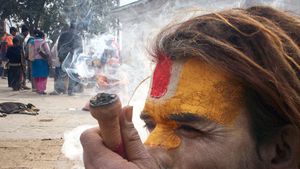Drug
A drug is, in the broadest of terms, a chemical substance that has known biological effects on humans or other animals. Foods are generally excluded from this definition, in spite of their physiological effects on animal species.
Drugs and Religion
Tribal Uses
In many cultures shamans do not use drugs and are able to journey without them.[1] Natives from northern Mexico and Southwestern United States have been known to use peyote, a psychedelic containing mescaline.[2] In the Amazon, shamans use ayahuasca, a psychedelic containing DMT, for their journeys.[3]
Uses by Occultists
- Aleister Crowley was prescribed heroin for his asthma, a common medical practice at the time, and became addicted like anyone would. He later used heroin recreationally and sacramentally, as he did with many drugs including cocaine, hashish, ether, peyote, and pretty much anything that he could get his hands on to try. He was after all a scientist, trained as a chemist even, a mystic, and a psychonaut. His novel, “Diary of a Drug Fiend” is a celebration of sacramental drug use and of overcoming addiction.
Religion as a Product of Psychotropic Drug Use
The notion that hallucinogenic drugs played a significant part in the development of religion has been extensively discussed, particularly since the middle of the twentieth century. Various ideas of this type have been collected into what has become known as the entheogen theory.
The book “The Road to Eleusis: Unveiling the Secret of the Mysteries”, makes a case that the psycho-active ingredient in the secret kykeion potion used in the Eleusinian mysteries was most likely the ergotism causing fungus Claviceps purpurea. Furthermore the book introduced for the first time the term "entheogen" as an alternative for terms such as "psychedelic", "hallucinogen" and "drug" that can be misleading in certain contexts.
The book “The Apples of Apollo: Pagan and Christian Mysteries of the Eucharist” (2001) explores the role that entheogens in general, and Amanita muscaria in particular, played in Greek and biblical mythology and later on in Renaissance painting, most notably in the Isenheim Altarpiece by Matthias Grünewald.

References
- ↑ Cranes, White (Sept 22, 2009). Shamans and psychedelic drugs.
- ↑ Peyote.
- ↑ Pow, Helen (Dec 9, 2013). Hallucinogenic drug used in Amazonian Shamanic....